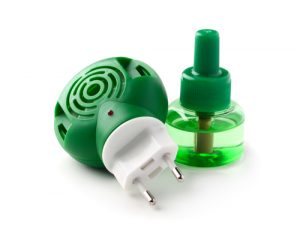The Truth About Ultrasonic Pest Repellers
By Chris Williams on December 13, 2011.
Q. I’ve seen several ads for these ultrasonic pest repellers that you plug into an electrical outlet to rid your home of cockroaches, mice, and everything else. Do these things work?
A. In a word, no. They’re sold by various names such as ultrasonic devices, electronic pest repellers, microvibration systems, and electromagnetic pest repellers. They claim to use high frequency sound waves, seismic vibrations, or electromagnetic output to repel insects, rodents, moles, deer, virtually any pests. We saw one that claimed to combine ultrasonic, electromagnetic, and ionic technologies for maximum power! The concept is that the high frequency noise (which is above the range of human hearing but can supposedly be detected by pests) greatly disturbs pests, driving them from the area or killing them.
Some of the repellers plug directly into a wall outlet; others are a black box that sits on a table. Prices range from $15.99 to $59.99. About the only thing that they all have in common is a red indicator light on the front, and the fact that they don’t work.
 The fact that they don’t work is not just our opinion. It’s the conclusion of researchers, other pest control experts, and the federal government. There is no credible scientific evidence that shows that these devices have any significant repellent effect on pests. Devices that were tested by several universities were found not to work. Most insects do not have “ears” and have no way to detect ultrasonic sound. The devices did not affect cockroach behavior, or even their distribution within a room. Ultrasonic flea devices did not kill fleas or affect flea hatch or larval development.
The fact that they don’t work is not just our opinion. It’s the conclusion of researchers, other pest control experts, and the federal government. There is no credible scientific evidence that shows that these devices have any significant repellent effect on pests. Devices that were tested by several universities were found not to work. Most insects do not have “ears” and have no way to detect ultrasonic sound. The devices did not affect cockroach behavior, or even their distribution within a room. Ultrasonic flea devices did not kill fleas or affect flea hatch or larval development.
While many manufacturers have dropped their claims of insect control, they still claim that the devices will repel rodents. Testing of ultrasonic devices has shown that about half of the sound energy is gone within 15 feet of the device and any object in the room blocks the sound. A typical room would need a number of devices strategically placed in order to saturate the entire space. Besides, mice quickly become used to regularly repeated sounds and return to their nesting sites and foraging routes. There is little evidence that sound of any type will drive established mice or rats from a building.
EPA does not register pest control devices, so the manufacturers do not have to submit any data proving that their product actually does what they say it does. Some of the product manufacturers have been prosecuted by the Environmental Protection Agency or the Federal Trade Commission for making false claims. The Armed Forces has issued a policy statement that “electromagnetic exclusion or control devices, ultrasonic repellent or control devices…will not be procured or maintained with public funds,” and that personnel should “discourage the use of these devices by pointing out their relative ineffectiveness.”
So, why do some people swear that these devices work to repel pests? Wishful thinking? Or maybe the pests died out or moved on? Or, maybe no one wants to admit that they’ve been taken for $39.99 for a black plastic box with a blinking red light. Be a smart consumer; save your money.